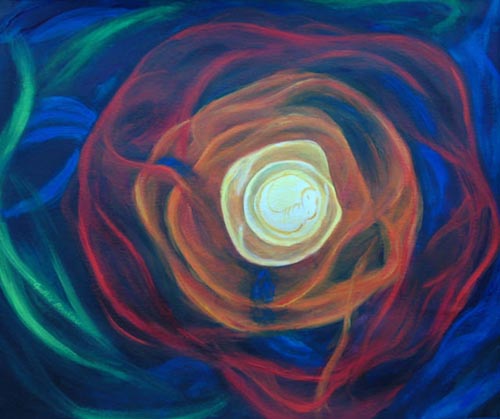Organizers:
Yong-Zhong Qian
qian@physics.umn.edu
Tom Abel
tabel@stanford.edu
Timothy Beers
beers@pa.msu.edu
Alexander Heger
alex@ucolick.org
Talks online
Application form
Program Coordinator:
Nancy Tate
tate@phys.washington.edu
(206) 685-4286
Early Universe
Co-sponsored by LANL and JINA
June 19 to July 21, 2006

Artwork by Cynthia Brehmer
Modeling the formation of the first stars using ab initio cosmological simulations recently has become possible because of the rapid increase in available computing power and novel numerical techniques. Due to the unique initial composition of these stars and possibly very large masses for some of them, their radiation spectra, evolution, explosions, and nucleosynthesis are very different from stars that form today. Several groups have studied the nucleosynthesis of these stars, but large uncertainties remain. Reionization and metal enrichment of the universe have been investigated by a number of groups. Direct simulations of metal enrichment by the first stars and formation of the second generation of stars will be feasible within the next few years.
On the observational side, WMAP and distant quasars discovered through SDSS have shed light on the reionization history of the universe. Observations of quasar absorption systems at high redshift and metal-poor stars in the Galaxy with large telescopes, such as VLT, Subaru, and Keck, have provided a multitude of data on metal abundances over a wide range of cosmic times. Extensive studies have been carried out for a large number of stars with iron abundances below 1% of the solar value, including two stars below 0.001% of the solar value. Such iron abundances, and the associated abundance patterns, are thought to arise from enrichment by the first few generations of stars. Other observational studies, such as HERES and SEGUE, promise to build up even more extensive and statistically complete databases of metal-poor stars.
In this program we bring together theorists, experimentalists, and observers with a wide range of expertise in cosmology and nuclear astrophysics to link theoretical, experimental, and observational studies. We will integrate the current knowledge into a form that can guide new theory and the next generation of numerical simulations and observational programs with high-sensitivity instruments. Our main goals are to address the following unresolved issues: What is the mass spectrum of the first stars? How do they evolve and die? How are their metals mixed into the intergalactic medium and eventually incorporated into the next generation of stars? Can their nucleosynthesis products be identified? How important are they to reionization of the universe? How do they affect subsequent structure and star formation?